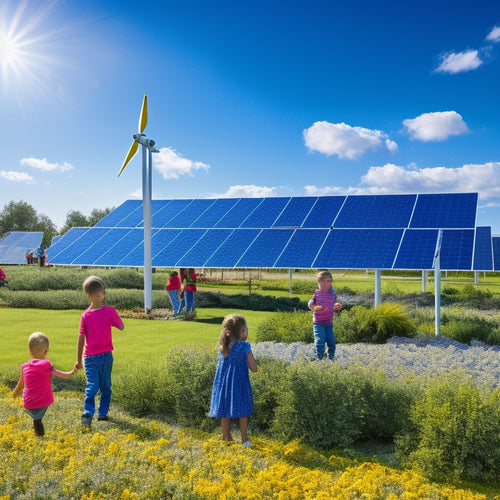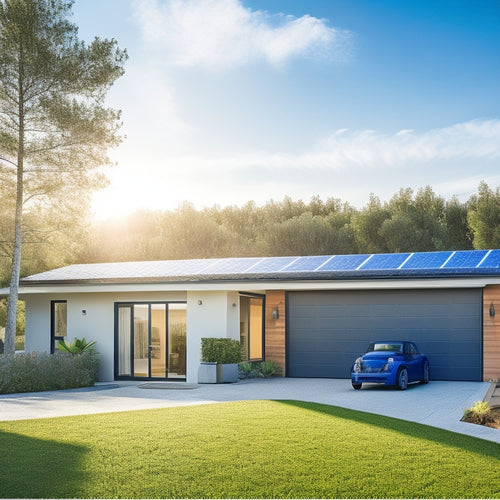
What's the True Cost of Solar Panels for Homes?
Share
Installing solar panels for your home costs between $15,000 to $25,000 initially. Installation expenses range from $5,500 to $17,000, covering materials, labor, and permits. Yearly maintenance averages $150, along with extended warranty fees. Federal tax credits and state incentives can decrease costs by up to 30%. Solar panels greatly lower your energy bills, potentially saving $10,000 to $30,000 over two decades. Financing options like loans or leasing affect upfront costs and long-term savings. To understand how these factors integrate into your financial planning and energy savings, continue exploring the topic.
Key Takeaways
- Initial purchase prices for solar panels range from $15,000 to $25,000.
- Installation costs, including equipment, labor, and permits, range from $5,500 to $17,000.
- Federal tax credits and state-specific incentives can significantly reduce the overall cost.
- Maintenance expenses are minimal, averaging $150 per year for routine cleaning and inspection.
- Homeowners can save $10,000 to $30,000 on energy bills over 20 years.
Initial Purchase Price
https://www.youtube.com/watch?v=YmMcC4bJ32w
The initial purchase price of solar panels for homes typically ranges from $15,000 to $25,000, depending on the system size and installation specifics. When you start comparing brands, you'll notice that prices can vary greatly. High-efficiency options like those from SunPower may cost more upfront but offer greater long-term savings. Conversely, brands like Canadian Solar offer more budget-friendly options without drastically compromising on performance.
Timing your purchase is important. Prices for solar panels have been decreasing steadily, but waiting too long might mean missing out on current incentives or rebates. Additionally, supply chain disruptions can affect availability and costs, so staying informed about market conditions is essential.
When conducting a brand comparison, consider factors like panel efficiency, warranty periods, and customer reviews. Higher initial costs don't always equate to better long-term value. For instance, a brand offering a 25-year warranty and high-efficiency ratings might save you more on energy bills over time, despite a higher initial outlay.
Installation Costs
When considering installation costs, you should factor in equipment and materials expenses, which typically range from $3,000 to $10,000.
Labor fees can add another $2,000 to $5,000, depending on system complexity and regional rates.
Additionally, permit fees may vary between $500 and $2,000, influenced by local regulations.
Equipment and Materials Expenses
Calculating installation costs involves considering expenses for solar panels, inverters, mounting hardware, and labor. When you evaluate these components, understanding panel durability is essential. High-quality solar panels typically last 25-30 years, which justifies a higher initial investment. On average, panels cost between $2.50 to $3.50 per watt, so a 6-kilowatt system could run you around $15,000 to $21,000 before incentives.
Inverters, responsible for converting DC electricity to usable AC, also play a significant role in cost. The inverter lifespan generally ranges from 10 to 15 years, necessitating at least one replacement during your system's lifetime. Expect to pay between $1,000 and $3,000 for a quality inverter.
Mounting hardware, including racks and brackets, can add another $500 to $3,000. This hardware must withstand various weather conditions, contributing to overall system longevity.
While labor costs vary based on location and system complexity, the equipment and material expenses form a substantial portion of your total outlay.
Labor and Permit Fees
Labor and permit fees typically account for 10% to 20% of your total solar installation costs, directly impacting your budget. These expenses cover contractor fees, which include the labor involved in setting up your solar system, and the various inspection costs required to guarantee compliance with local regulations. On average, you might spend between $3,000 and $5,000 on these fees alone, depending on your location and the complexity of the installation.
Contractor fees are primarily influenced by the hourly rates of skilled labor and the number of hours needed to complete the installation. Highly experienced contractors might charge more, but their expertise can ensure a smoother installation process. Additionally, inspection costs vary based on local government requirements. You'll typically need several inspections throughout the installation process, from initial site evaluation to final system approval.
Understanding these costs is essential for accurate budgeting and planning. By factoring in labor and permit fees, you can better anticipate the total investment needed for your solar energy system.
Embracing solar technology not only reduces your carbon footprint but also brings you closer to energy independence, a vital step toward personal liberation.
Maintenance Expenses
Maintenance expenses for solar panels are typically minimal, averaging around $150 per year for routine cleaning and inspection. The cleaning frequency largely depends on your local environment. For instance, areas with high dust, pollen, or pollution levels might require more frequent cleaning, potentially twice a year. Conversely, regions with regular rainfall may only need an annual check-up.
Most modern solar panels come with extended warranty coverage, often ranging from 20 to 25 years. This warranty usually includes protection against manufacturing defects and guarantees a certain level of efficiency. However, reviewing your warranty terms is crucial to understand what specific maintenance tasks are covered. In many cases, the warranty can reduce unexpected repair costs significantly, offering a safety net for your investment.
Neglecting maintenance can lead to efficiency drops, impacting your energy production. Therefore, adhering to a consistent maintenance schedule is important. Investing in professional cleaning services and regular inspections ensures your panels operate at peak efficiency. By doing so, you not only extend the life of your system but also maximize your energy output, aligning with your desire for liberation from conventional energy sources.
This proactive approach helps you maintain a sustainable, cost-effective solar energy system.
Energy Savings
Switching to solar panels can greatly reduce your monthly energy bills, offering substantial long-term savings on electricity costs. By generating your own power, you can greatly cut down your dependence on the grid. On average, homeowners see a 70-90% reduction in their electricity bills post-installation. Over a 20-year period, this translates to savings of $10,000 to $30,000, depending on your location and energy usage.
Solar panels convert sunlight into electricity through photovoltaic cells, providing a reliable and renewable source of energy. This not only leads to reduced bills but also shields you from fluctuating energy prices. In many regions, utility rates increase by 2-3% annually. By investing in solar, you effectively lock in your energy costs, enjoying the long-term benefits of price stability.
Additionally, net metering programs can further enhance your savings. Any surplus electricity your system generates can be fed back into the grid, earning you credits on future bills. This maximizes your investment, ensuring that your solar panels work efficiently even when you're not home.
Ultimately, the energy savings from solar panels empower you to achieve greater financial independence and sustainability.
Tax Incentives
You can greatly reduce the cost of installing solar panels through various tax incentives. Federal tax credits offer up to 26% savings, while state-specific incentives and local rebate programs vary widely but can further lower your expenses.
Researching these options will provide a clearer picture of potential financial benefits.
Federal Tax Credits
Homeowners can benefit from significant federal tax credits that reduce the overall cost of installing solar panels. The federal Investment Tax Credit (ITC) currently offers a 30% credit on solar energy systems installed on residential properties. This credit can substantially lower your initial investment, making solar panel installation more financially accessible.
To qualify for the ITC, there are specific eligibility criteria you must meet. First, the solar system must be installed between January 1, 2020, and December 31, 2032. Next, the system must be new and located at your primary or secondary residence in the United States. Additionally, you must own the solar system outright—leased systems don't qualify for the federal tax credit.
It's important to note the credit expiration details. The 30% credit is set to remain in place until 2032. Starting in 2033, the credit will decrease to 26%, and in 2034, it will further drop to 22%. Unless extended by Congress, the ITC will expire for residential installations after 2034.
Acting sooner rather than later could maximize your financial benefits and accelerate your journey toward energy independence.
State-Specific Incentives
Many states offer extra tax incentives that can greatly reduce the cost of installing solar panels on your home. These incentives vary widely based on local utility regulations and weather impact, both of which can affect your overall savings. Understanding these incentives can empower you to make a more informed decision and maximize your investment.
Here's a quick snapshot of some state-specific incentives:
| State | Tax Credit (%) | Weather Impact |
|---|---|---|
| California | 26% | High Sunlight |
| New York | 25% | Moderate |
| Texas | 22% | High Sunlight |
| Florida | 20% | High Sunlight |
| Illinois | 18% | Low Sunlight |
California's high sunlight and supportive utility regulations make it a prime location for solar panel installations, offering significant tax credits. New York provides a substantial tax credit, though you might face moderate weather impact, which could affect efficiency. Texas and Florida, both with high sunlight and favorable utility regulations, offer good incentives as well. Illinois, despite lower sunlight, still incentivizes solar panel installation to boost renewable energy usage.
Evaluating the utility regulations in your state alongside these tax incentives allows you to gauge potential savings accurately. By leveraging these incentives, you can reduce initial costs, making solar energy a more attainable and liberating energy solution.
Local Rebates Programs
Local rebate programs can greatly reduce the net cost of solar panel installation by providing immediate financial incentives. These programs often come from local governments or utility companies aiming to promote renewable energy usage.
When you apply for these rebates, you must navigate the application process and meet specific eligibility criteria. The application process typically involves submitting documentation outlining your solar project, such as installation contracts and system specifications. Some programs require pre-approval before installation begins, which means you should plan accordingly to make sure you're eligible for the rebate.
Eligibility criteria can vary widely depending on your location. Common factors include the type of property (residential or commercial), the capacity of the solar system, and sometimes even household income levels. By meeting these criteria, you can substantially lower your upfront investment, making solar power more accessible and aligning with your desire for energy independence.
Data from the Database of State Incentives for Renewables & Efficiency (DSIRE) shows that local rebates can cover anywhere from 10% to 30% of the installation costs, depending on the program specifics. As such, taking advantage of these local rebates is an important step in minimizing your solar panel expenses and achieving greater autonomy in your energy consumption.
Financing Options
When considering the cost of solar panels for your home, exploring financing options such as solar loans, leases, and power purchase agreements (PPAs) can help manage upfront expenses. Solar loans allow you to own the system while spreading the cost over several years. Loan terms typically range from 5 to 20 years, and interest rates can vary based on your credit score and the lender. A lower interest rate can greatly reduce your long-term costs, making it a financially viable option.
Leasing options provide another pathway, where you don't own the solar panels but pay a monthly fee to use them. This can lower your initial investment to zero or near-zero. Leases generally last 20 to 25 years, and the leasing company is responsible for maintenance. However, you may not benefit from local rebates or federal tax credits, as the leasing company retains ownership.
Power purchase agreements (PPAs) involve paying for the electricity generated by the solar panels rather than the panels themselves. This model offers predictable monthly payments and eliminates maintenance concerns. However, you won't own the system, which could impact the total savings you can achieve.
Choose the option that aligns best with your financial goals and liberation aspirations.
Frequently Asked Questions
How Do Solar Panels Affect Home Resale Value?
Imagine your home as an investment. Solar panels can positively influence resale factors and align with market trends. Data shows homes with solar panels often sell faster and at a higher price, enhancing your property's value.
What Happens to Solar Panels During Extreme Weather Conditions?
When extreme weather hits, you can count on the panel durability and weather resilience of modern solar installations. They're designed to withstand high winds, heavy snow, and hail, ensuring consistent performance and minimal damage.
Are There Any Health Risks Associated With Solar Panels?
Imagine harnessing the sun's power safely. You won't face significant health risks from solar panels. Electromagnetic fields are minimal, and proper installation prevents fire hazards. Embrace renewable energy and liberate yourself from fossil fuels.
How Do Solar Panels Impact Home Insurance Policies?
When you install solar panels, insurance premiums might increase due to higher home value. Coverage adjustments are necessary to protect against potential damages, ensuring your investment's safeguarded. Always notify your insurer to update your policy accurately.
What Is the Environmental Impact of Manufacturing Solar Panels?
You should consider the environmental impact of manufacturing solar panels, which involves significant resource extraction and manufacturing emissions. Despite these factors, solar panels generally offer a net positive effect on long-term environmental sustainability and energy liberation.
Related Posts
-

Solar Power for Community Energy Independence
Solar power is essential for your community's energy independence, offering both environmental and economic benefits....
-

Solar Energy Storage Options for Homes
When considering solar energy storage options for your home, you'll find several effective solutions. Battery systems...
-

Energy-Efficient Heating and Cooling Appliances
Energy-efficient heating and cooling appliances can cut your energy bills markedly. By opting for models with high En...


